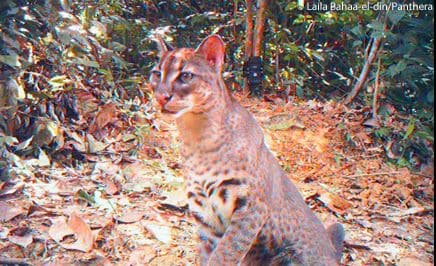The elusive African golden cat (Profelis aurata), about twice the size of an average domestic cat, has been captured on video for the first time at the Kibale National Park in Uganda while it was hunting red colobus monkeys.
According to Panthera, a global wild cat conservation organization, the video footage shows the cat, whose body and tail are 80 cm (31 in) and 30 cm (12 in) long respectively, hunting red colobus monkeys that were feeding on the dead wood of a tree stump.
Kibale Project Manager for the Max Planck Institute for Evolutionary Anthropology’s Pan African Program, Samuel Angedakin, had set up a camera trap to film chimpanzees.
Samuel Angedakin had been working together with the Uganda National Council for Science and Technology, the Ngogo Chimpanzee Project, and the Uganda Wildlife Authority.

African golden cat (Credit: Laila Bahaa-el-din. Image: Panthera)
A camera set up in the Kalinzu Forest Reserve by Yasuko Tashiro of the Primate Research Institute at Kyoto University recorded further footage of a golden cat sleeping in a tree. It shows a group of monkeys harassing the cat until it climbs down.
African golden cat threatened by human activity
The African golden cat is found only in the rainforests of West and Central Africa. It is about the size of a bobcat, slightly smaller than a lynx, and weighs between 5 to 16 kilograms. Males are larger than females.
The elusive feline has been observed by very few western scientists. Nearly all records consist of photographs taken by remote camera traps, or dead animals usually killed by local hunters.
According to Panthera, the African golden cat is threatened across its range by hunters who kill it for meat, and deforestation.
Two Kaplan Scholars are currently being funded by Panthera to carry out African golden cat studies in Uganda and Gabon.
Panthera’s Kaplan Scholar, Laila Bahaa-el-din, captured some of the first known footage of a wild African Golden cat in Gabon in 2011. Cameras had been set up as part of a graduate research project together with the University of Oxford’s Wildlife Conservation Research Unit (WildCRU) and the University of KwaZulu-Natal (UKZN).
The research aims to understand how different levels of human activity, such as hunting and logging, affect the African golden cat.
Video – African Golden cat hunting red colobus monkeys
David Mills, a UKZN graduate and Kaplan Scholar, is also researching the species in Uganda’s Kibale Forest, where the African golden cat is the region’s top predator ever since the leopard became extinct.
The first wild photo of a living African golden cat was taken in 2002 by a camera trap set up by Dr. Philipp Henschel, Panthera’s Lion Program Survey Coordinator. He is also credited with taking the first handheld pictures of the animal in 2003.
Mr. Mills, explained:
“It is an exciting and rare glimpse into the world of this fascinating cat. We know a lot more about golden cats than we did a few years ago and yet we still know almost nothing about their behavior.”
“Primatologists in Kibale have observed monkeys emitting alarm calls at golden cats on several occasions and, considering this latest evidence, it’s not hard to see why.”
Ms. Bahaa-el-din added:
“An adult red colobus monkey is a considerable opponent for an African golden cat. With the golden cat failing to make a fatal bite immediately on ambush, it had to make a hasty retreat. Watching a golden cat in full ambush of large monkeys in this video provides hunting details we could previously only piece together from brief sightings.”
“It also portrays nicely why monkeys might mob a golden cat, as can be seen in the unique footage of a golden cat trying in vain to catch a cat nap while precariously perched in the fork of a tree.”
Video – African golden cat being harassed by monkeys

